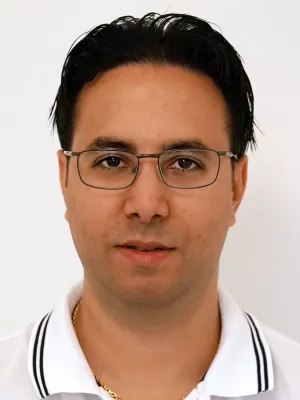
Rafi Sheikh
Research project participant

Revascularization of Free Skin Grafts Overlying Modified Hughes Tarsoconjunctival Flaps Monitored Using Laser-Based Techniques
Author
Summary, in English
Purpose: It has recently been shown that the flap pedicle does not supply blood to a tarsoconjunctival graft in the modified Hughes procedure in patients. This raises questions concerning the rate of revascularization of the free skin graft commonly used to reconstruct the anterior lamella. The aim of this study was, thus, to monitor the course of revascularization in free skin grafts overlying modified Hughes tarsoconjunctival flaps, using laser-based techniques.
Methods: Free skin grafts from the upper eyelid or upper arm in 9 patients were used to cover a tarsoconjunctival flap according to the modified Hughes procedure. Blood perfusion was monitored using laser speckle contrast imaging, and vascular reactivity was studied with laser Doppler velocimetry after heating the tissue to 44°C. Measurements were made at the time of surgery (baseline) and at 1, 3, 8, and 16 weeks postoperatively.
Results: The gradual increase in perfusion of the free skin grafts during the healing process indicates revascularization. A slight increase in perfusion was seen already after 1 week. Perfusion reached 50% of the baseline after 3 weeks, and complete restoration of perfusion was seen after 8 weeks. The vascular function monitored with heat-induced hyperemia increased in a similar fashion.
Conclusions: Full-thickness skin grafts revascularize within 3 to 8 weeks, despite overlying a tarsoconjunctival flap, which has recently been reported to be avascular. This provides further evidence that it should be possible to repair large eyelid defects using free full-thickness eyelid grafts.
Methods: Free skin grafts from the upper eyelid or upper arm in 9 patients were used to cover a tarsoconjunctival flap according to the modified Hughes procedure. Blood perfusion was monitored using laser speckle contrast imaging, and vascular reactivity was studied with laser Doppler velocimetry after heating the tissue to 44°C. Measurements were made at the time of surgery (baseline) and at 1, 3, 8, and 16 weeks postoperatively.
Results: The gradual increase in perfusion of the free skin grafts during the healing process indicates revascularization. A slight increase in perfusion was seen already after 1 week. Perfusion reached 50% of the baseline after 3 weeks, and complete restoration of perfusion was seen after 8 weeks. The vascular function monitored with heat-induced hyperemia increased in a similar fashion.
Conclusions: Full-thickness skin grafts revascularize within 3 to 8 weeks, despite overlying a tarsoconjunctival flap, which has recently been reported to be avascular. This provides further evidence that it should be possible to repair large eyelid defects using free full-thickness eyelid grafts.
Department/s
- Ophthalmology Imaging Research Group
- NPWT technology
- Thoracic Surgery
Publishing year
2019-07
Language
English
Pages
378-382
Publication/Series
Ophthalmic Plastic and Reconstructive Surgery
Volume
35
Issue
4
Document type
Journal article
Publisher
Lippincott Williams & Wilkins
Topic
- Ophthalmology
Status
Published
Project
- Blood Perfusion in Flaps during Reconstructive Surgery after Tumor Excision around the Eyes Investigated by Laser Speckle Contrast Imaging in Humans
Research group
- Ophthalmology Imaging Research Group
- NPWT technology
ISBN/ISSN/Other
- ISSN: 1537-2677

